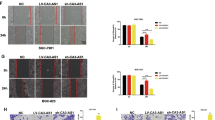Abstract
Long noncoding RNAs (lncRNAs) play an important role in cancer occurrence and development. However, there is largely unknown about lncRNAs significance in the diagnosis and treatment of gastric cancer. In our study, we focused on AC130710, one of lncRNAs. Gastric cancer tissues and adjacent tissues were gathered from 78 patients with gastric cancer. The AC130710 levels were detected by reverse transcription polymerase chain reaction (RT-PCR). Then, we further analyzed the association between AC130710 level and the clinicopathological factors of patients with gastric cancer. Finally, the molecular mechanism underling AC130710 highly expressed in gastric cancer cells was explored. The results showed that AC130710 in cancer tissues from patients with gastric cancer was significantly higher than those in adjacent noncancerous tissues (P < 0.05). Its expression level was significantly associated with tumor size (P = 0.013), tumor-node-metastasis (TNM) stages (P = 0.030), and distal metastasis (P = 0.018). AC130710 expression in MGC-803 was significantly higher than that in normal gastric mucosa cell line GES-1 (P < 0.001). Moreover, miR-129-5p may play an important role in the downregulation of AC130710 in gastric cancer cells. These results indicated that lncRNA-AC130710 may be a potential tumor marker for gastric cancer prognosis.




Similar content being viewed by others
References
Ferlay J, Shin HR, Bray F, Forman D, Mathers C, Parkin DM. Estimates of worldwide burden of cancer in 2008: GLOBOCAN 2008. Int J Cancer. 2010;127:2893–917.
Lin LL, Huang HC, Juan HF. Discovery of biomarkers for gastric cancer: a proteomics approach. J Proteomics. 2012;75:3081–97.
Tahira AC, Kubrusly MS, Faria MF, Dazzani B, Fonseca RS, Maracaja-Coutinho V, et al. Long noncoding intronic RNAs are differentially expressed in primary and metastatic pancreatic cancer. Mol Cancer. 2011;10:141.
Guttman M, Rinn JL. Modular regulatory principles of large non-coding RNAs. Nature. 2012;482:339–46.
Guttman M, Amit I, Garber M, French C, Lin MF, Feldser D, et al. Chromatin signature reveals over a thousand highly conserved large non-coding RNAs in mammals. Nature. 2009;458:223–7.
Guo F, Li Y, Liu Y, Wang J, Li Y, Li G. Inhibition of metastasis-associated lung adenocarcinoma transcript 1 in CaSki human cervical cancer cells suppresses cell proliferation and invasion. Acta Biochim Biophys Sin (Shanghai). 2010;42:224–9.
Rinn JL, Kertesz M, Wang JK, Squazzo SL, Xu X, Brugmann SA, et al. Functional demarcation of active and silent chromatin domains in human HOX loci by noncoding RNAs. Cell. 2007;129:1311–23.
Sobin LH, Compton CC. TNM seventh edition: what’s new, what’s changed: communication from the International Union Against Cancer and the American Joint Committee on Cancer. Cancer. 2010;116:5336–9.
Sun W, Wu Y, Yu X, Liu Y, Song H, Xia T, et al. Decreased expression of long noncoding RNA AC096655.1-002 in gastric cancer and its clinical significance. Tumour Biol. 2013;34:2697–701.
Song H, Sun W, Ye G, Ding X, Liu Z, Zhang S, et al. Long non-coding RNA expression profile in human gastric cancer and its clinical significances. J Transl Med. 2013;11:225.
Mei D, Song H, Wang K, Lou Y, Sun W, Liu Z, et al. Up-regulation of SUMO1 pseudogene 3 (SUMO1P3) in gastric cancer and its clinical association. Med Oncol. 2013;30:709.
Yu X, Song H, Xia T, Han S, Xiao B, Luo L, et al. Growth inhibitory effects of three miR-129 family members on gastric cancer. Gene. 2013;532:87–93.
Yang F, Xue X, Zheng L, Bi J, Zhou Y, Zhi K, et al. Long non-coding RNA GHET1 promotes gastric carcinoma cell proliferation by increasing c-Myc mRNA stability. FEBS J. 2014;281:802–13.
Zhao Y, Guo Q, Chen J, Hu J, Wang S, Sun Y. Role of long non-coding RNA HULC in cell proliferation, apoptosis and tumor metastasis of gastric cancer: a clinical and in vitro investigation. Oncol Rep. 2014;31:358–64.
Cheng Y, Jin Z, Agarwal R, Ma K, Yang J, Ibrahim S, et al. LARP7 is a potential tumor suppressor gene in gastric cancer. Lab Invest. 2012;92:1013–9.
Wang W, Li YF, Sun XW, Chen YB, Li W, Xu DZ, et al. Prognosis of 980 patients with gastric cancer after surgical resection. Chin J Cancer. 2010;29:923–30.
Wang X, Wan F, Pan J, Yu GZ, Chen Y, Wang JJ. Tumor size: a non-neglectable independent prognostic factor for gastric cancer. J Surg Oncol. 2008;97:236–40.
Adachi Y, Oshiro T, Mori M, Maehara Y, Sugimachi K. Tumor size as a simple prognostic indicator for gastric carcinoma. Ann Surg Oncol. 1997;4:137–40.
Lu J, Huang CM, Zheng CH, Li P, Xie JW, Wang JB, et al. Consideration of tumor size improves the accuracy of TNM predictions in patients with gastric cancer after curative gastrectomy. Surg Oncol. 2013;22:167–71.
Saito H, Osaki T, Murakami D, Sakamoto T, Kanaji S, Oro S, et al. Macroscopic tumor size as a simple prognostic indicator in patients with gastric cancer. Am J Surg. 2006;192:296–300.
Li C, Oh SJ, Kim S, Hyung WJ, Yan M, Zhu ZG et al. Risk factors of survival and surgical treatment for advanced gastric cancer with large tumor size. J Gastrointest Surg. 2009;13881-5.
Acknowledgments
This work was supported by the National Natural Science Foundation of China (No. 81171660), the Zhejiang Provincial Natural Science Foundation of China (No. LY14C060003), the Applied Research Project on Nonprofit Technology of Zhejiang Province (Nos. 2012C23127 and 2014C33222), the Scientific Innovation Team Project of Ningbo (No. 2011B82014), the Project of Outstanding Youth Health Technical Personnel of Ningbo, the Postgraduate Scientific Innovation Foundation of Ningbo University (No. G14069), and the K. C. Wong Magna Fund in Ningbo University.
Conflicts of interest
None
Author information
Authors and Affiliations
Corresponding author
Rights and permissions
About this article
Cite this article
Xu, C., Shao, Y., Xia, T. et al. lncRNA-AC130710 targeting by miR-129-5p is upregulated in gastric cancer and associates with poor prognosis. Tumor Biol. 35, 9701–9706 (2014). https://doi.org/10.1007/s13277-014-2274-5
Received:
Accepted:
Published:
Issue Date:
DOI: https://doi.org/10.1007/s13277-014-2274-5




